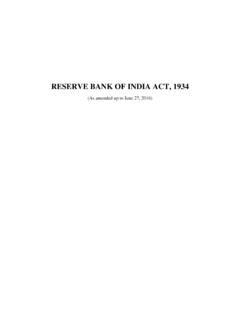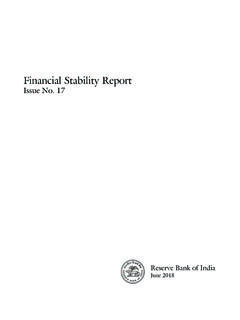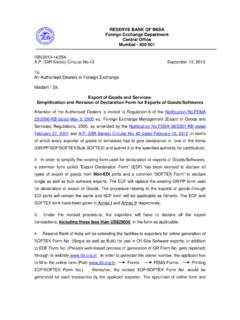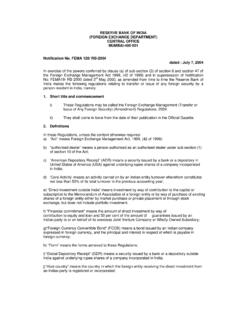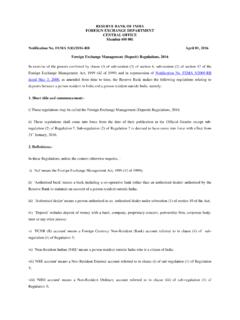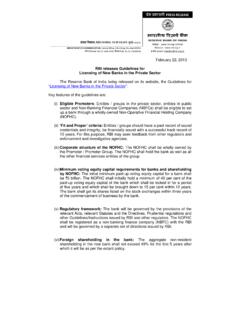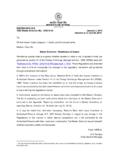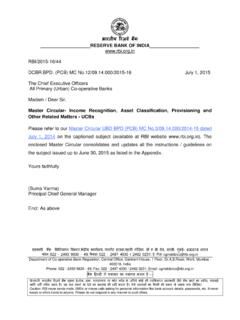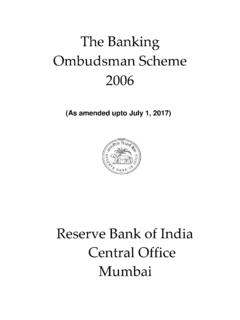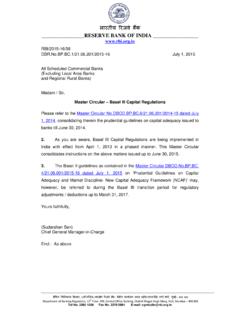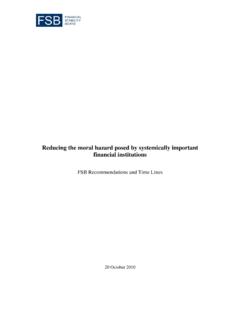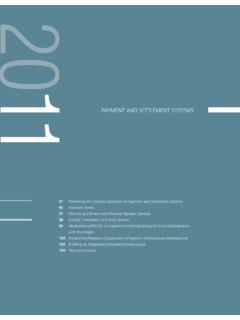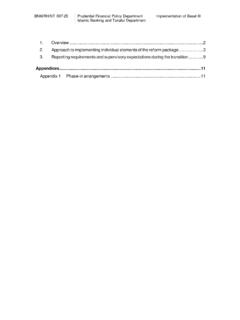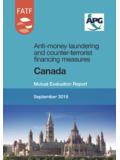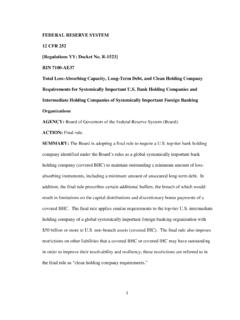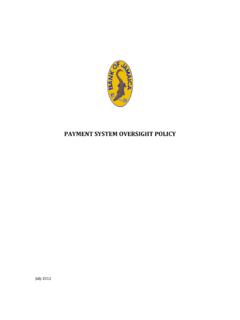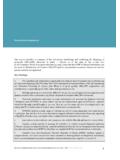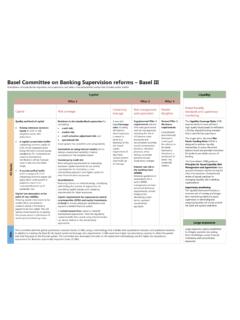Transcription of RESERVE BANK OF INDIA DEPARTMENT OF NON-BANKING ...
1 RESERVE BANK OF INDIADEPARTMENT OF NON-BANKING SUPERVISIONCENTRAL OFFICECENTRE I, WORLD TRADE CENTRECUFFE PARADE, COLABAMUMBAI 400 005 NOTIFICATION No. DNBS. 193 DG(VL)-2007 dated February 22 , 2007 The RESERVE Bank of INDIA , having considered it necessary in the public interest, andbeing satisfied that, for the purpose of enabling the Bank to regulate the creditsystem to the advantage of the country, it is necessary to issue the Directionsrelating to the prudential norms as set out below, in exercise of the powers conferredby Section 45JA of the RESERVE Bank of INDIA Act, 1934 (2 of 1934) and of all thepowers enabling it in this behalf, and in supersession of the NON-BANKING FinancialCompanies Prudential Norms ( RESERVE Bank)
2 Directions, 1998 contained inNotification No. DFC. 119/DG(SPT)/98 dated January 31, 1998, gives to every NON-BANKING financial company not accepting / holding public deposits the Directionshereinafter title, commencement andapplicability of the Directions:1. (1) These Directions shall be known as the " NON-BANKING Financial (Non- DepositAccepting or Holding) Companies Prudential Norms ( RESERVE Bank) Directions,2007". (2) These Directions shall come into force with immediate effect.(3) (i) The provisions of these Directions save as provided for in clauses (ii)(iii) and (iv) hereinafter, shall apply to -every NON-BANKING financial company not accepting / holding publicdeposits.
3 (ii) The provisions of paragraphs 16 and 18 of these Directions shall notapply to - (a) a loan company; (b) an investment company; (c) an asset finance companywhich is not a systemically important non-deposit taking non-bankingfinancial company.(iii) These Directions shall not apply to a NON-BANKING financial company being2an investment company; Provided that, it is(a) holding investments in the securities of its group/ holding/ subsidiarycompanies and book value of such holding is not less than ninety percent of its total assets and it is not trading in such securities;(b) not accepting/holding public deposit.
4 And(c) is not a systemically important non-deposit taking NON-BANKING , the provisions of paragraphs 16 and 18 shall be applicable to suchinvestment companies which are systemically important non-deposit takingnon-banking financial company.(iv) These Directions except the provisions of paragraph 19 shall not apply tonon-banking financial company being a Government company as definedunder Section 617 of the Companies Act, 1956 (1 of 1956) and notaccepting / holding public (1) For the purpose of these Directions, unless the context otherwise requires:(i) break up value means the equity capital and reserves as reduced byintangible assets and revaluation reserves, divided by the number of equityshares of the investee company;(ii) carrying cost means book value of the assets and interest accrued thereonbut not received.
5 (iii) current investment means an investment which is by its nature readilyrealisable and is intended to be held for not more than one year from thedate on which such investment is made;(iv) doubtful asset means :(a)a term loan, or(b)a lease asset, or(c)a hire purchase asset, or(d)any other asset,which remains a sub-standard asset for a period exceeding 18 months;3(v) earning value means the value of an equity share computed by taking theaverage of profits after tax as reduced by the preference dividend andadjusted for extra-ordinary and non-recurring items, for the immediatelypreceding three years and further divided by the number of equity shares ofthe investee company and capitalised at the following rate: (a) in case of predominantly manufacturing company, eight per cent; (b) in case of predominantly trading company, ten per cent; and (c) in case of any other company, including NON-BANKING financial company,twelve per cent.
6 NOTE : If, an investee company is a loss making company, the earning valuewill be taken at zero;(vi) fair value means the mean of the earning value and the break up value;(vii) hybrid debt means capital instrument which possesses certaincharacteristics of equity as well as of debt;(viii) infrastructure loan means a credit facility extended by NON-BANKING financialcompanies to a borrower, by way of term loan, project loan subscription tobonds/debentures/ preference shares / equity shares in a project companyacquired as a part of the project finance package such that suchsubscription amount to be in the nature of advance or any other form oflong term funded facility provided to a borrower company engaged in: Developing or Operating and maintaining, or Developing, operating and maintainingany infrastructure facility that is a project in any of the following sectors.
7 A)a road, including toll road, a bridge or a rail system;b)a highway project including other activities being an integral partof the highway project;c)a port, airport, inland waterway or inland port;d)a water supply project, irrigation project, water treatmentsystem, sanitation and sewerage system or solid waste managementsystem;e)telecommunication services whether basic or cellular, includingradio paging, domestic satellite service ( , a satellite owned andoperated by an Indian company for providing telecommunicationservice), network of trunking, broadband network and internetservices;f)an industrial park or special economic zone;g)generation or generation and distribution of power;h)transmission or distribution of power by laying a network of newtransmission or distribution lines;i)construction relating to projects involving agro-processing andsupply of inputs to agriculture;4j)construction for preservation and storage of processed agro-products, perishable goods such as fruits, vegetables and flowersincluding testing facilities for quality;k)construction of educational institutions and hospitals; andl)any other infrastructure facility of similar nature.
8 (ix) loss asset means:(a) an asset which has been identified as loss asset by the non-bankingfinancial company or its internal or external auditor or by the ReserveBank of INDIA during the inspection of the NON-BANKING financialcompany, to the extent it is not written off by the NON-BANKING financialcompany; and(b) an asset which is adversely affected by a potential threat of non-recoverability due to either erosion in the value of security or nonavailability of security or due to any fraudulent act or omission on thepart of the borrower;(x) long term investment means an investment other than a current investment;(xi) net asset value means the latest declared net asset value by the mutualfund concerned in respect of that particular scheme;(xii) net book value means:(a) in the case of hire purchase asset, the aggregate of overdue and futureinstalments receivable as reduced by the balance of unmatured financecharges and further reduced by the provisions made as per paragraph9(2)(i) of these Directions.
9 (b) in the case of leased asset, aggregate of capital portion of overduelease rentals accounted as receivable and depreciated book value ofthe lease asset as adjusted by the balance of lease adjustmentaccount.(xiii) non-performing asset (referred to in these Directions as NPA )means:(a) an asset, in respect of which, interest has remained overdue for aperiod of six months or more;(b) a term loan inclusive of unpaid interest, when the instalment is overduefor a period of six months or more or on which interest amountremained overdue for a period of six months or more;(c) a demand or call loan, which remained overdue for a period of sixmonths or more from the date of demand or call or on which interestamount remained overdue for a period of six months or more.
10 5(d) a bill which remains overdue for a period of six months or more;(e) the interest in respect of a debt or the income on receivables under thehead `other current assets in the nature of short term loans/advances,which facility remained overdue for a period of six months or more;(f) any dues on account of sale of assets or services rendered orreimbursement of expenses incurred, which remained overdue for aperiod of six months or more;(g) the lease rental and hire purchase instalment, which has becomeoverdue for a period of twelve months or more;(h) in respect of loans, advances and other credit facilities (including billspurchased and discounted), the balance outstanding under the creditfacilities (including accrued interest) made available to the sameborrower/beneficiary when any of the above credit facilities becomesnon-performing asset:Provided that in the case of lease and hire purchase transactions, a NON-BANKING financial company may classify each such account on the basis ofits record of recovery.
